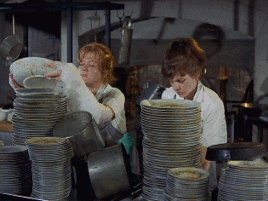Like many other Boston College students, I was told that PULSE was going to be a life-changing experience. For those of you who don’t know, PULSE is a 6 credit class offered at BC that combines Theology and Philosophy with a 12 hour-a-week community service commitment.
Being the lover of food that I am, I chose to fulfill my weekly requirement at Haley House, a soup kitchen located in the South End of Boston. I knew I would learn about the homeless community of Boston, and potentially ~sharpen~ my cooking skills but I never thought I would learn as many fascinating things as I did.
Here are 10 of the numerous lessons I learned during my time there.
1. Breakfast food can be anything.

GIF courtesy of giphy.com
When you think breakfast food, what comes to mind? Pancakes? Waffles? Eggs Benedict? That’s what I thought too, until I started working at the Haley House. On my first shift at 6:00 am, I walked into the kitchen and was stunned by the pungent smell of fish. Not like that of smoked salmon that pairs very nicely with a bagel and cream cheese – but the smell of raw tilapia filets.
What was on the menu that day, you may ask? Tilapia with tomato salsa, white rice and salad. For breakfast. That was when I learned that anything can be breakfast food; breakfast prescribes when you eat, not what you eat.
2. There is no limit to what you can put in your coffee.

GIF courtesy of giphy.com
I always thought coffee was served only with milk and maybe a little bit of sugar. Boy was I wrong. Apparently coffee goes great with just about anything. CHEESE? Why not?! BUTTER? Of course! APPLE JUICE? Toss it in there! PEANUT BUTTER? Make it creamy! After seeing people add all these different ingredients into their coffee mugs, shockingly I wasn’t grossed out, I just realized: I really need to step up my coffee game.
3. Dessert should follow ALL meals.

GIF courtesy of giphy.com
We all know that dessert is traditionally served after dinner and sometimes after lunch if you need something sweet – a cookie or brownie can really complete a meal. But what about breakfast? Who decided that breakfast should not be followed by something sweet?
At Haley House, we’ve served dessert after breakfast countless times, and every time, it rocked. Banana bread pudding, chocolate chip pumpkin bread, “caramelitas” and apple crumble are just a few of the desserts that received 5 star reviews from our guests at the Haley House. So next time your stomach grumbles after you’ve taken your last bite of egg, pick up and enjoy whatever sweet your tooth desires.
4. Your donations are much more important than you think.

GIF courtesy of giphy.com
You know all of those times you have been asked to donate canned food to a soup kitchen? How you’re never 100% sure whether or not that canned alphabet soup ACTUALLY gets used by kitchen? Well, it does. Every donation counts.
Every bean, grain of rice, strand of pasta and drop of ketchup find their way onto the plate of a hungry customer. That is what keeps the kitchen running. So if you are ever being asked to donate food to a soup kitchen and are debating whether or not to do so because you aren’t sure if you are really making a difference, do it, because you are.
5. There are some great companies that save food that is going to be thrown out.

GIF courtesy of giphy.com
Ever wondered what a company like Whole Foods does with the strawberries that don’t get sold on the day of their expiration? Or what Trader Joe’s does with all of their leftover food? They toss it out. Luckily for us at the Haley House, there are companies whose mission is to redirect edible food headed to the garbage onto the plates of those in need.
Lovin’ Spoonfuls is a non-profit organization that delivers this food to the Haley House. And they don’t just secure food from Whole Foods and Trader Joe’s, but also from produce wholesalers, farmers and farmer’s markets all around Boston. It’s thanks to them that, to this day, over 3 million pounds of food have been rescued, and countless people have had access to nourishing food that would have otherwise been tossed out.
6. Chicken is an all-time favorite for breakfast.

GIF courtesy of giphy.com
You’d expect pancakes, french toast or eggs to be the crowd-pleasers but to my surprise, it turns out they’re not. For some reason, chicken is our best “seller.” Maybe it’s because chicken tastes delicious, or because it’s a food that fills you up for a long time, but people always ask if we are serving chicken, and sigh when the answer is no.
7. People love food that reminds them of home.

GIF courtesy of giphy.com
Who doesn’t? Food has (in my opinion) the power to transport you; with a single bite or sniff, food can take you back to childhood – the details of the memory coming to life each time you bring the fork to your lips. At the Haley House, I was lucky enough to bring that experience to the large population of Puerto Rican guests. Being from Puerto Rico myself, it was a pleasure to remind everyone (including myself) of home with the flavors of onion and pepper “sofrito,” oregano, tomato sauce, cilantro and kidney beans, in a classic Puerto Rican rice in beans.
The meal, I believe, was 100 times tastier just because it had that nostalgic element to it, which I have come to realize, is the case for most meals.
8. Good company can make any job fun.

Nothing quite screams “fun” like being on dish-washing or grilling duty at the Haley House. Reluctantly reaching your hands into the bottom of a murky sink unsure of what kind of mushy surprise you’ll find can be rough. As can grilling nearly 70 homemade salmon patties that release a “perfume” that will stick to your hair, skin, and clothing like glue for the rest of the day.
But, there is one thing that makes these discomforts disappear, and that’s the company. At the Haley House you don’t have to worry about finding kind, interesting and unique people to be by your side at either station, making the job, not just bearable, but fun.
9. Not all soup kitchens are created equal.

GIF courtesy of giphy.com
This is something I learned the minute I stepped into the Haley House. A quaint, brightly colored soup kitchen, playing soft, uplifting music, the Haley House breaks all preconceived ideas you may have of what a soup kitchen looks like.
Before coming to the Haley House, when I thought of a soup kitchen, I always visualized one of two things: an enormous space with a huge assembly line plopping slop onto plates, or a smaller version of this in which there is a still a massive division between the people serving food, and those receiving it.
This is where the Haley House differs. There is no division between the kitchen and the seating area, breaking any boundaries that exist between the people at the kitchen. Once you enter the door of the Haley House, you are all just people. While yes we do have an assembly line for serving the food (because that is just extremely efficient), we do not just leave it at that.
After preparing and serving the meal, all the volunteers sit and eat with the guests. Over the year, I created friendships, not just with volunteers and Haley House staff, but with the guests themselves, because we have worked, eaten and existed together.
In addition, after every shift, everyone who has volunteered at the Haley House participates in a reflection – a minute and a half moment of silence, followed by a reflection question – to think about what we are doing, about ourselves, about the world. It’s something you would never associate with a soup kitchen, but something I am proud to say the Haley House does.
10. Food really does bring people together.

GIF courtesy of giphy.com
Some of the best conversations I’ve ever had have taken place during the preparation and the consumption of food. There’s something about having a mouth full of food and trying to speak, that for some reason, go together perfectly. At the Haley House, food is the glue that brings everyone together.
Their policy on not dividing the kitchen from the seating area, having the volunteers eat along with the guests, and keeping a positive energy in the soup kitchen make Haley House the quintessential example of a place in which food creates an atmosphere of friendship and love.
That is why their mission statement is “Food With A Purpose & The Power of Community.” Its purpose is not only to provide healthy, wholesome food to the male homeless population of Boston, but also, and maybe most importantly, to bring people together.


